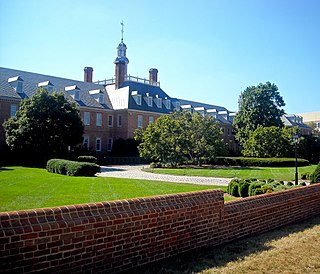Related Research Articles

Investment banking is an advisory-based financial service for institutional investors, corporations, governments, and similar clients. Traditionally associated with corporate finance, such a bank might assist in raising financial capital by underwriting or acting as the client's agent in the issuance of debt or equity securities. An investment bank may also assist companies involved in mergers and acquisitions (M&A) and provide ancillary services such as market making, trading of derivatives and equity securities, FICC services or research. Most investment banks maintain prime brokerage and asset management departments in conjunction with their investment research businesses. As an industry, it is broken up into the Bulge Bracket, Middle Market, and boutique market.

The Goldman Sachs Group, Inc. is an American multinational investment bank and financial services company. Founded in 1869, Goldman Sachs is headquartered in Lower Manhattan in New York City, with regional headquarters in many international financial centers. Goldman Sachs is the second largest investment bank in the world by revenue and is ranked 55th on the Fortune 500 list of the largest United States corporations by total revenue. In Forbes Global 2000 2023, Goldman Sachs ranked 34th. It is considered a systemically important financial institution by the Financial Stability Board.
A bailout is the provision of financial help to a corporation or country which otherwise would be on the brink of bankruptcy. A bailout differs from the term bail-in under which the bondholders or depositors of global systemically important financial institutions (G-SIFIs) are forced to participate in the recapitalization process but taxpayers are not. Some governments also have the power to participate in the insolvency process; for instance, the U.S. government intervened in the General Motors bailout of 2009–2013. A bailout can, but does not necessarily, avoid an insolvency process. The term bailout is maritime in origin and describes the act of removing water from a sinking vessel using a bucket.

First Busey Bank is a financial institution headquartered in Champaign, Illinois, and operates in Illinois, Indiana, and southwest Florida. It is owned by First Busey Holding, a financial holding company.

Huntington Bancshares Incorporated is an American bank holding company headquartered in Columbus, Ohio. The company is ranked 466th on the Fortune 500 as of 2024, and is 26th on the list of largest banks in the United States.
This article outlines the history of Wells Fargo & Company from its merger with Norwest Corporation and beyond. The new company chose to retain the name of "Wells Fargo" and so this article is about the history after the merger.

WesBanco, Inc., is a bank holding company headquartered in Wheeling, West Virginia, United States. It has over 200 branches in West Virginia, Ohio, Western Pennsylvania, Kentucky, Maryland, and Southern Indiana.
Pacific Capital Bancorp was a bank headquartered in Santa Barbara, California. It had 47 branches, all of which were in Southern California. It operated under the name Santa Barbara Bank & Trust. The company also operated Morton Capital Management and R.E. Wacker Associates, investment advisory firms. In 2012, the company was acquired by MUFG Union Bank.

In September 2008, the Federal Housing Finance Agency (FHFA) announced that it would take over the Federal National Mortgage Association and the Federal Home Loan Mortgage Corporation. Both government-sponsored enterprises, which finance home mortgages in the United States by issuing bonds, had become illiquid as the market for those bonds collapsed in the subprime mortgage crisis. The FHFA established conservatorships in which each enterprise's management works under the FHFA's direction to reduce losses and to develop a new operating structure that will allow a return to self-management.
The Emergency Economic Stabilization Act of 2008, also known as the "bank bailout of 2008" or the "Wall Street bailout", was a United States federal law enacted during the Great Recession, which created federal programs to "bail out" failing financial institutions and banks. The bill was proposed by Treasury Secretary Henry Paulson, passed by the 110th United States Congress, and was signed into law by President George W. Bush. It became law as part of Public Law 110-343 on October 3, 2008. It created the $700 billion Troubled Asset Relief Program (TARP), which utilized congressionally appropriated taxpayer funds to purchase toxic assets from failing banks. The funds were mostly redirected to inject capital into banks and other financial institutions while the Treasury continued to examine the usefulness of targeted asset purchases.
The government interventions during the subprime mortgage crisis were a response to the 2007–2009 subprime mortgage crisis and resulted in a variety of government bailouts that were implemented to stabilize the financial system during late 2007 and early 2008.
The Troubled Asset Relief Program (TARP) is a program of the United States government to purchase toxic assets and equity from financial institutions to strengthen its financial sector that was passed by Congress and signed into law by President George W. Bush. It was a component of the government's measures in 2009 to address the subprime mortgage crisis.
The Term Asset-Backed Securities Loan Facility (TALF) is a program created by the U.S. Federal Reserve to spur consumer credit lending. The program was announced on November 25, 2008, and was to support the issuance of asset-backed securities (ABS) collateralized by student loans, auto loans, credit card loans, and loans guaranteed by the Small Business Administration (SBA). Under TALF, the Federal Reserve Bank of New York authorized up to $200 billion of loans on a non-recourse basis to holders of certain AAA-rated ABS backed by newly and recently originated consumer and small business loans. As TALF money did not originate from the U.S. Treasury, the program did not require congressional approval to disburse funds, but an act of Congress forced the Fed to reveal how it lent the money. The TALF began operation in March 2009 and was closed on June 30, 2010. TALF 2 was initiated in 2020 during the COVID-19 pandemic.
The Emergency Economic Stabilization Act created the Troubled Asset Relief Program to administer up to $700 billion. Several oversight mechanisms are established by the bill, including the Congressional Oversight Panel, the Special Inspector General for TARP (SIGTARP), the Financial Stability Oversight Board, and additional requirements for the Government Accountability Office (GAO) and the Congressional Budget Office (CBO).
The Capital Assistance Program is a U.S. Treasury program that provides capital injections in exchange for mandatory convertible preferred stock and warrants to bank holding companies.
The Subprime mortgage crisis solutions debate discusses various actions and proposals by economists, government officials, journalists, and business leaders to address the subprime mortgage crisis and broader 2007–2008 financial crisis.

On March 23, 2009, the United States Federal Deposit Insurance Corporation (FDIC), the Federal Reserve, and the United States Treasury Department announced the Public–Private Investment Program for Legacy Assets. The program is designed to provide liquidity for so-called "toxic assets" on the balance sheets of financial institutions. This program is one of the initiatives coming out of the implementation of the Troubled Asset Relief Program (TARP) as implemented by the U.S. Treasury under Secretary Timothy Geithner. The major stock market indexes in the United States rallied on the day of the announcement rising by over six percent with the shares of bank stocks leading the way. As of early June 2009, the program had not been implemented yet and was considered delayed. Yet, the Legacy Securities Program implemented by the Federal Reserve has begun by fall 2009 and the Legacy Loans Program is being tested by the FDIC. The proposed size of the program has been drastically reduced relative to its proposed size when it was rolled out.
The subprime mortgage crisis reached a critical stage during the first week of September 2008, characterized by severely contracted liquidity in the global credit markets and insolvency threats to investment banks and other institutions.
The National City acquisition by PNC was the deal by PNC Financial Services to acquire National City Corp. on October 24, 2008 following National City's untenable loan losses during the subprime mortgage crisis. The deal received much controversy due to PNC using TARP funds to buy National City only hours after accepting the funds while National City itself was denied funds, as well as civic pride for the city of Cleveland, Ohio, where National City was based.
Philadelphia financier Jay Cooke established the first modern American investment bank during the Civil War era. However, private banks had been providing investment banking functions since the beginning of the 19th century and many of these evolved into investment banks in the post-bellum era. However, the evolution of firms into investment banks did not follow a single trajectory. For example, some currency brokers such as Prime, Ward & King and John E. Thayer and Brother moved from foreign exchange operations to become private banks, taking on some investment bank functions. Other investment banks evolved from mercantile firms such as Thomas Biddle and Co. and Alexander Brothers.
References
- ↑ GA0 Report GAO-09-161 published 12/02/2008
- ↑ Langley, Paul (2015). Liquidity Lost: The Governance of the Global Financial Crisis. Oxford University Press. pp. 82–86. ISBN 978-0199683789.
- ↑ "Gordon Does Good". The New York Times. October 12, 2008. Retrieved February 5, 2016.
- ↑ Wilson, Linus; Wu, Yan Wendy (December 29, 2009). "Common (Stock) Sense about Risk-Shifting and Bank Bailout". SSRN 1321666.
- ↑ Wilson, Linus (February 2, 2009). "Debt Overhang and Bank Bailouts". SSRN 1336288.
- ↑ "Paulson's Gift" (PDF). Working Paper, University of Chicago. November 5, 2008. Archived from the original (PDF) on March 20, 2009. Retrieved February 2, 2009.
- ↑ McIntire, Mike. Bailout Is a Windfall to Banks, if Not to Borrowers. New York Times January 17, 2009.
- ↑ "Summer letter of the President elect" (PDF). The Wall Street Journal. January 15, 2009.
- ↑ "The Troubled Asset Relief Program Report on Transactions Through December 31, 2008". CBO. January 16, 2009. Retrieved January 26, 2009.
- ↑ "FACT SHEET FINANCIAL STABILITY PLAN" (PDF). U.S. Treasury. February 10, 2009. Archived from the original (PDF) on March 11, 2009. Retrieved March 11, 2009.
- ↑ "Capital Purchase Program Revenues Have Exceeded Investments, but Concerns about Outstanding Investments Remain". CBO. March 1, 2012. Retrieved October 4, 2012.
- ↑ SIGTARP, (2009), Office of the Special Inspector General for the Troubled Asset Relief Program, Quarterly Report to Congress: April 21, 2009, accessed online on May 5, 2009, at http://www.sigtarp.gov/reports/congress/2009/April2009_Quarterly_Report_to_Congress.pdf Archived 2010-01-07 at the Wayback Machine .
- ↑ Paletta, Damian (2009-04-22). "Financial Firms Lobby to Cut Cost of TARP Exit - WSJ". WSJ. Retrieved 2024-06-05.
- ↑ "The Goldman Sachs Warrants". May 7, 2009. SSRN 1400995.
- ↑ John Carney, Apr. 23, 2009, “Goldman Sachs Is NOT Lobbying to Expunge the TARP Warrants,” accessed online on May 1, 2009